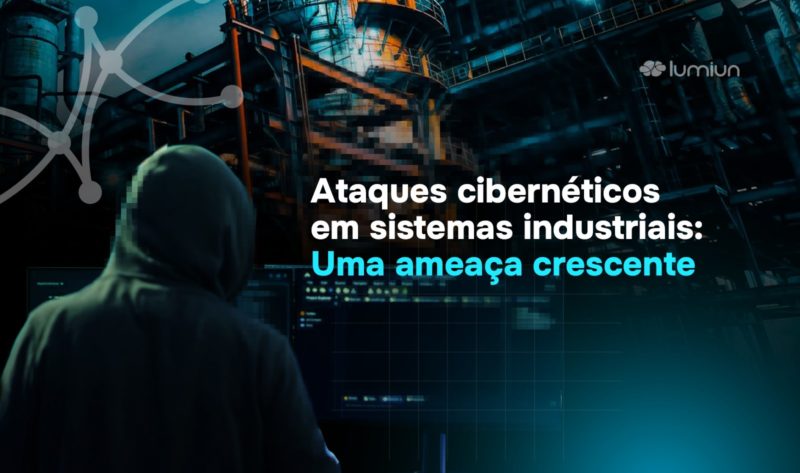In recent years, the threat of cyber attacks against industrial systems has become increasingly alarming. Thus, the increasing digitalization energy , manufacturing , critical infrastructure and transportation sectors has meant that systems that previously operated in isolation have become exposed to a wider range of vulnerabilities .
The increasing digitalization of industry, with automation and the interconnection of devices, exposes companies to an increasing risk of cyber attacks. One of the most common is the brute force attack, where hackers repeatedly try to guess passwords to access systems. Furthermore, this practice becomes even more dangerous in industrial environments, where an invasion can cause significant interruptions in production and generate financial losses. The addition of automation and the use of connected devices in networks increases the attack surface , making security a priority.
Therefore, the protection of these infrastructures goes far beyond traditional security measures. Therefore, adopting advanced strategies multi-factor and firewall solutions , is essential to face the challenges of industrial networks.
The interconnection between operational and information technology creates an ideal environment for cybercriminals looking to exploit security flaws . Only a robust approach can combat the risks of cyberattacks on industrial systems, which are vital for operational continuity and security.
Therefore, the interconnection between operational and IT networks creates an ideal environment for cybercriminals to exploit security flaws.
What are brute force attacks on Industrial Systems?
Brute force attacks are intrusions in which cybercriminals attempt to access systems by automatically testing various combinations of login credentials and passwords . In the context of industrial systems, this technique seeks to exploit vulnerabilities in devices and control systems that often use default credentials or weak passwords . Therefore, increasing interconnectivity and industrial automation has made this type of attack an increasingly common threat
CISA ( US Cybersecurity and Infrastructure Security Agency) reported that attacks on industrial devices exposed on the internet are becoming increasingly common. Additionally, attackers often use simple methods, such as brute force attacks and default credentials, to compromise industrial control systems.
Industrial systems that rely on operational technologies (OT) and industrial control systems (ICS) can suffer serious consequences from a successful brute force attack. By gaining unauthorized access to these systems, cybercriminals can cause production disruptions, physically damage equipment, and even compromise the security of critical infrastructure such as power plants. In other words, the consequences of a successful attack can be devastating for companies and society. Combating brute force attacks involves taking proactive measures such as multi-factor authentication , implementing strict security policies , and regularly updating passwords . Therefore, these approaches help prevent cybercriminals from gaining access to systems, mitigating the impact of possible invasion attempts.
Brute force attacks concept
Brute force attacks are one of the oldest forms of cyber attack, where the attacker tries to guess password combinations repeatedly until they find the correct one. Brute force refers to the rudimentary but effective approach of testing all possible combinations of credentials. This is possible through automated that try millions of combinations per second , especially when the system uses or excessively weak passwords .
According to Unit 42's 2022 incident response report , brute force credential attacks contributed to 20% of attacks that were successful in the period.
Furthermore, the use of default credentials in industrial systems represents a critical vulnerability, facilitating the execution of brute force attacks. Many devices and control systems come with default passwords that, if not changed, allow unauthorized access to networks and sensitive data by cybercriminals. This highlights the importance of good password management practices and rigor to ensure that these settings are replaced with stronger passwords .
Therefore, the consequences of a successful attack in industrial environments can be devastating. Furthermore, the interruption of critical processes, damage to equipment and compromised data security are just some of the possible consequences.
Default credentials make life easier for cybercriminals. In other words, by using pre-defined passwords on devices and systems, companies open the door to brute force attacks. To strengthen security, it is essential to implement temporary account locking after multiple failed login attempts and constantly monitor network activities.
How brute force attacks work
Brute force attacks work by repeating login attempts, using different combinations of usernames and passwords until the correct combination is found. Thus, cybercriminals can use common password dictionaries , leaked data from other platforms and random sequences to speed up this process.
Furthermore, many of these industrial systems are not designed with the same cybersecurity IT systems . This makes brute force attacks effective, exploiting known vulnerabilities or weak credentials to gain control over critical systems.
Given this, a successful brute force attack can allow the attacker to shut down machines , manipulate production processes, and even cause catastrophic failures . Furthermore, it is necessary to mention the financial consequences for companies. According to IBM's 2024 Cost of a Data Breach report , the global average cost of a data breach in 2024 has seen a 10% , reaching nearly $4.9 million .
To mitigate these attacks, it is essential to adopt basic security practices , such as locking out accounts after multiple login attempts, multi-factor authentication , and , unique passwords Although they seem simple, these measures make it significantly more difficult for cybercriminals to carry out attacks of this type, increasing the protection of systems.
Default credentials and their vulnerabilities
One of the biggest vulnerabilities in industrial systems is the use of default credentials . Additionally, many ICS generic passwords and usernames , which end up being used by companies. In other words, these credentials are easily accessible on the internet or in factory manuals , making the system susceptible to intrusions.
The practice of maintaining default credentials exposes the system to unnecessary risks. administrators often underestimate the impact of these settings, believing that network isolation or physical security would be a sufficient approach to prevent attacks. However, increased connectivity and systems integration have made these approaches largely obsolete .
For this reason, one of the top recommendations for mitigating brute force attacks is to immediately replace all credentials . Therefore, it is critical to implement more secure passwords and authentication practices to avoid unnecessary vulnerabilities and keep operations secure.
Industrial Systems at risk'
The convergence between information technology (IT) and operational technology (OT) in Industry 4.0 exposes industrial systems to increasingly greater cyber risks. The proliferation of connected devices and the Internet of Things (IoT) expands the attack surface, creating new opportunities for cybercriminals to exploit vulnerabilities and compromise critical operations. Furthermore, the impact of a cyberattack on an industrial system can be devastating . A criminal who manages to compromise a control system can cause interruptions in operations , cause damage and failures to machines and also cause financial losses . Accompanied by this can also come damage to the company's reputation, being a particularly high risk in sectors such as energy , manufacturing and transport .
To face this challenge, industries need to invest in security solutions for industrial systems, such as firewalls specially designed for OT network monitoring systems intrusion detection tools . Thus, by adopting these technologies, companies are able to protect their systems against the main threats and vulnerabilities.
What are Industrial Control Systems?
Industrial control systems are used to monitor and control industrial processes in sectors such as energy, manufacturing, transportation and water treatment. These systems play a fundamental role in managing complex and critical operations, allowing companies to automate their processes and increase their efficiency .
ICS include the use of various technologies such as distributed control systems , programmable logic controllers , and SCADA systems . As essential as they are, ICS have inherent vulnerabilities that make them attractive targets for cybercriminals. Many of these systems were developed at a time when cybersecurity was not a key concern, meaning they may not have been designed with the robustness needed to withstand modern attacks . The interconnection of ICS with the IT network also exposes these systems to previously undemanding external threats
To protect ICS against attacks, it is necessary for companies to adopt specific security practices, such as network segmentation, implementation of industrial firewalls and data encryption . Constant vigilance and security auditing are also approaches that can help identify vulnerabilities and ensure systems are protected against cyberattacks.
Impact of attacks and critical infrastructure
Disruption of essential services such as energy, water and transport, resulting from cyber attacks on critical infrastructure, can have catastrophic consequences. A blackout, for example, can paralyze hospitals, transport systems and various industrial activities, impacting millions of people. In addition, damage may occur that extends to industrial operations that depend on continued energy supply.
In this sense, the financial consequences of this type of attack can be worrying. The cost of a cyberattack can be exorbitant, involving equipment repair or replacement, legal expenses, and lost revenue from outages.
Therefore, industries operating critical infrastructure must adopt a proactive approach to cybersecurity. This involves not only implementing advanced defense technologies , but also carrying out regular risk assessments , training employees and creating a incident response plan .
Most affected sectors
According to Cyber Security Ventures' Official Annual Cybercrime Report 2023, an important point of vulnerability has been identified in critical infrastructures. Organizations in this sector face heightened risks due to increasingly sophisticated threats, causing substantial damage to these organizations.
The sectors most affected by cyberattacks on industrial systems include energy, transportation, manufacturing and healthcare. In the energy sector, for example, electrical power plants and distribution networks are frequent targets, given their importance to society. We know that a successful attack can result in large-scale power outages , affecting not only industry but also essential services and the population.
Logistics and transportation face substantial cyber challenges, with attacks that can disrupt the supply chain and delay the delivery of essential products, generating significant economic impacts. The increasing digitalization of these sectors makes it even more vital to implement robust security measures to mitigate risks and protect operations.
In the case of manufacturing , disruptions caused by cyber attacks can lead to production stops and financial losses. The implementation of connection technologies such as industry 4.0 , although very beneficial in terms of efficiency, also increases vulnerability to attacks.
Another valuable example is the transportation . Being an increasingly growing target of attacks of this type, the Control System that manages air, rail and road traffic is very critical for public security. Attacks of this type can cause mass accidents
A recent cyber attack suffered by the company Ward Transport & Logistics highlighted this concern. On March 3, 2024, Ward Transport & Logistics was the target of a cyber attack that affected several layers of its network.
Consequence of the attacks
The consequences of a large-scale cyber attack on an industrial system can be devastating and span many dimensions. An immediate consequence is the interruption of operations , leading to significant financial losses and having a major impact on the ability to deliver products and services. In the case of industrial environments, the downtime of machines on the production line also generates very high costs, not only due to inactivity, but also due to the repercussions on the supply chain.
In addition to these financial issues, cyber attacks can cause physical damage to equipment and infrastructure. For example, if criminals gain access to the industrial control system, it is possible for them to change the operating settings of a machine, causing mechanical failures or even accidents .
Finally, reputation can also be seriously affected after such an attack. Loss of trust on the part of customers and business partners leads to a drop in sales and jeopardizes future contracts, as well as causing the company to face legal action and regulatory penalties , especially when it is unable to demonstrate that it has taken adequate measures to protect data and systems.
Alarming increase in attacks: data and trends
The alarming increase in cyber attacks on industrial systems is evidenced through a series of reports and studies carried out annually. Data from the Cyber Security and Infrastructure Security Agency (CISA) indicates that attacks on the industrial control system have increased dramatically in recent years, highlighting the urgent need to adopt more stringent protection measures.
In 2023, the United States Infrastructure Cybersecurity Agency critical security flaws affecting numerous products. These flaws can be exploited by a cybercriminal to gain unauthorized access to servers, altering information and creating a denial of service condition . An example of this are the flaws linked to Sewio's RTLS Studio, which can make the system vulnerable to an attacker, allowing the attacker to gain unauthorized access to the server, change information, create denial of service conditions, gain elevated privileges and execute arbitrary code .
Fortinet reports also corroborate this trend, revealing that the number of intrusion attempts has skyrocketed, putting infrastructure security at risk. According to a survey released in June this year, almost a third of OT reported more than 6 intrusions in the last year, an increase of 11% compared to the previous year.
Additionally, some practices must be implemented to improve the security posture of organizations, such as implementing network segmentation , and controls for OT assets , adopting OT- , among many others.
Attack growth trends
In recent years, the growth of cyber attacks shows that there has been a significant increase in the number of attacks compared to previous periods, reflecting a worrying trend . This growth can be mainly attributed to the greater interconnection of systems and the adoption of digital technologies in the industrial environment.
According to data from the Verizon Data Breach Investigations Report (DBIR) from recent years, attacks have grown exponentially:
- 2020: Approximately 100,000 cyberattacks reported globally.
- 2021: Growth to 300,000 attacks, a 200% increase.
- 2022: 500,000 attacks recorded, reflecting a 67% increase compared to 2021.
- 2023: Attacks reach 1 million, representing 100% growth compared to 2022.
In response to this growing concern, several industries have been investing more in cybersecurity . advanced technologies , Machine Learning , Artificial Intelligence and monitoring are being implemented to detect and respond to attacks in real time. However, it is also necessary to raise awareness among employees , especially regarding the protection of credentials and the creation of more robust passwords .
How to protect your industrial systems against hackers
Protecting industrial systems from cyberattacks requires a multidisciplinary approach; one of the most effective measures is the implementation of strict access controls. By requiring multi-factor authentication, for example, companies ensure that only authorized users access critical systems, significantly strengthening security. Network segmentation is another highly recommended approach to protecting industrial systems. By isolating different parts of the network , the company is able to minimize the impact of a cyber attack, limiting attackers' ability to move laterally within the digital infrastructure. This practice is very important in environments where OT and IT are connected, helping to keep systems protected.
Investing in education and ongoing training is critical to strengthening an organization's cybersecurity. By empowering employees to identify and respond to threats, companies create an effective first line of defense. Promoting a culture of digital security, where everyone understands the importance of their actions, is essential to protect the organization's systems and data.
Best practices
Best practices for protecting industrial systems against cyberattacks are fundamental approaches to ensuring the integrity of operations . A comprehensive approach should include regularly updating systems and software to ensure all known vulnerabilities are patched. Furthermore, it is necessary to implement an update calendar , prioritizing critical systems that operate in high security environments.
Carrying out regular risk assessments is essential. These assessments help identify specific vulnerabilities within the framework and allow companies to develop strategies to mitigate them. In addition to this, creating a incident response plan is essential to ensure that teams know how to act in the face of an attack.
The success of any cybersecurity initiative depends on senior management engagement. By demonstrating support and commitment, leadership ensures the allocation of adequate resources and the promotion of a culture of safety throughout the organization. After all, cybersecurity is a strategic issue that requires involvement from all levels of the company.
Implementation of LGPD in industries: how to ensure data protection and prevent leaks
The implementation of the General Data Protection Law (LGPD) within the industry is an essential step for companies to be able to protect their sensitive information and prevent data leaks . The LGPD requires companies to adopt strict measures to maintain the privacy and security of personal information, especially in a scenario where cyberattacks are on the rise. This includes carrying out regular audits to identify stored personal data and ensure it is adequately protected.
When it comes to implementing the LGPD within the industry, it is essential to create and data security policies . The company must define how personal information collected , processed and stored reporting insecurity incidents . Implementing regular training for employees on the importance of data protection is essential to ensure compliance and awareness among everyone in the organization.
Furthermore, the adoption of security technologies such as encryption and monitoring tools can also help the company protect personal information against unauthorized access and leaks. It's important to remember that GDPR compliance not only helps avoid legal penalties , but also strengthens consumers' trust in a company's ability to protect their information.
Defense tools and technologies
The adoption of defense tools and technologies is essential for protecting industrial systems against cyber attacks . Among the main tools, we can mention industrial firewalls , which are applications specifically designed to monitor and control data traffic in industrial networks. These features help block unauthorized access and detect suspicious activity, providing an additional layer of security for critical systems.
Implementing intrusion detection and prevention systems is also important. These tools continually monitor the network for behavior and attack attempts, allowing security teams to respond promptly to potential threats . Using security information and event management (SIEM) can also help consolidate and analyze logs from different systems, making it easier to identify attack patterns .
The use of backup and data recovery is also essential to ensure the continuity of operations even in the face of a cyber attack. Regularly performing backups and storing them in a secure location ensures that the industry can restore its operations after an incident.
Fiwall and Content Filtering Solutions
Firewall and content filtering solutions play an important role in protecting industrial systems against cyber attacks. Firewalls are designed to monitor network traffic and protect the control system against unauthorized access in industries . These solutions offer the ability to establish custom rules that allow you to block traffic based on well-defined security policies .
Content filtering is a technique that helps control access to websites and applications that may pose security risks . Blocking phishing and other malicious content helps your company reduce the likelihood of cyberattacks , especially important in industrial environments.
Additionally, combining firewalls and content filtering can bring more robust protection to your organization. The implementation of solutions that work together helps to monitor, control and protect networks more effectively, minimizing the incidence of cyber attacks and bringing more integrity to operating systems .
Increasing productivity safely
Cybersecurity should not only be seen as a data protection issue, but also as a valuable opportunity to increase productivity within the industry . When companies adopt rigorous security measures, they create a safer and more reliable , resulting in greater operational efficiency . Employees feel more protected and informed about security policies, becoming even more likely to focus on their activities and contribute positively to results.
Implementing access control and content filtering , such as Lumiun DNS , can also help employees stay focused on their tasks. By restricting access to non-work related websites and content, companies can reduce distractions and increase overall efficiency . Therefore, this practice will not only protect your network, but also encourage a culture of productivity .
Implementing a safe work environment also facilitates innovation and the adoption of new technologies. When your employees have confidence in the security of systems and the protection of information, they will be more willing to explore new solutions and practices that can further improve the operational efficiency of your industry.
The Relationship between Digital Security and Productivity in Industries
The relationship between digital security and productivity within the industry is an important aspect for contemporary companies. robust cybersecurity measures , they not only protect their systems from attacks, they also create a work environment that promotes efficiency .
Additionally, implementing a proactive to cybersecurity also reduces downtime caused by attacks. Well-protected systems are less likely to experience outages, allowing operations to continue smoothly and deliver expected productivity . Mounted here, this approach will also reduce costs associated with outages and recoveries after incidents.
Implementing security solutions that do not compromise usability is essential to maximize your industry's productivity Modern security tools, like Lumiun DNS , must be seamlessly integrated into existing workflows, ensuring that employees can perform their tasks without encountering obstacles or interruptions .
How Blocking Inappropriate Websites Can Improve Your Employees' Focus
Blocking inappropriate websites is an effective practice that can significantly improve employee focus and productivity Restricting access to non-work-related websites helps companies reduce distractions and keep employees focused on their tasks. In addition to improving overall efficiency, this approach also creates a more professional and productive work environment.
Blocking inappropriate websites helps protect your company against threats present in the digital environment. Many websites that are considered inappropriate are also sources of malware and phishing , compromising your company's security and encouraging the confidential information .
Finally, establishing a clear policy on internet use in the workplace also promotes a culture of responsibility among your employees. It is important to make it clear that the use of inappropriate websites will not be tolerated, encouraging an environment where employees are able to focus on their activities and contribute to organizational success .
Digital Security Practices to Maximize Efficiency
Digital security practices are fundamental to maximizing efficiency in industries. A comprehensive approach may include implementing clear security policies , conducting training and employee awareness This will ensure that everyone understands the importance of cybersecurity and also knows what to do in the event of an incident .
Carrying out regular security audits is another very important practice. These audits help identify vulnerabilities and ensure that security measures are effective. Implementing an incident management system also allows companies to quickly respond to any threat, minimizing the impact of a potential cyber attack.
Adopting new security tools and technologies, such as multi-factor authentication , encryption , and blocking harmful websites, can help protect critical data and ensure that only authorized users can access sensitive information.
The Urgency of Preventive Action
As we can see, given the alarming increase in cyber attacks on industrial systems, preventive action is a necessary and urgent solution. It is important for companies to recognize that cybersecurity is a critical priority, not only to protect assets and information, but also to ensure the continuity of their operations.
more robust security measures , such as network segmentation , access control and employee training Adopting defense technology and creating a security culture in the organization makes a difference in protecting against these attacks. It is important for the company to invest in security, not seeing it as a cost, but as an essential strategy for long-term success.
The protection of industrial systems must be a responsibility shared by everyone. Through a collective commitment to cybersecurity productive and efficient work environment .
Immediate Measures for Critical Sectors
In the case of critical sectors , immediate measures are essential to face this growing threat of cyber attacks . Carrying out risk assessments to identify vulnerabilities in systems is very beneficial, taking into account not only the technologies used, but also operational procedures, in addition to employee awareness of cybersecurity.
Updating and strengthening security policies is another fundamental measure . Companies need to review and update their guidelines to ensure they are aligned with best practices and regulatory requirements.
In conclusion, collaboration between industry companies and government agencies cybersecurity challenges . Sharing information about threats and best practices can help strengthen and build resilience in critical infrastructure . Working together, industries are able to develop more effective strategies to protect their systems and ensure security in an increasingly digital .










